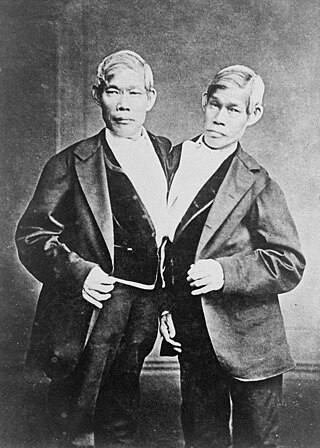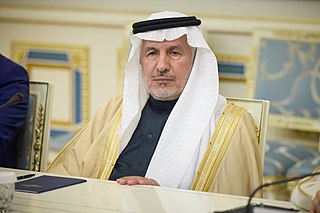
Conjoined twins, popularly referred to as Siamese twins, are twins joined in utero. It is a very rare phenomenon, estimated to occur in anywhere between one in 49,000 births to one in 189,000 births, with a somewhat higher incidence in Southwest Asia and Africa. Approximately half are stillborn, and an additional one-third die within 24 hours. Most live births are female, with a ratio of 3:1.

Chang Bunker and Eng Bunker were Siamese (Thai)-American conjoined twin brothers whose fame propelled the expression "Siamese twins" to become synonymous for conjoined twins in general. They were widely exhibited as curiosities and were "two of the nineteenth century's most studied human beings".

Craniopagus parasiticus is an extremely rare type of parasitic twinning occurring in about 2 to 3 of 5,000,000 births. In craniopagus parasiticus, a parasitic twin head with an undeveloped body is attached to the head of a developed twin. Fewer than a dozen cases of this type of conjoined twin have been documented in literature.
Keith Goh is a neurosurgeon from Singapore. Goh is known for his operations in separating conjoined twins with two known successful cases and a failed attempt in separating Ladan and Laleh Bijani.

Daisy and Violet Hilton were English-born entertainers who were conjoined twins. They were exhibited in Europe as children, and toured the United States sideshow, vaudeville and American burlesque circuits in the 1920s and 1930s. They were best known for their film appearances in Freaks and the biographic Chained for Life (1951).
Abigail Loraine Hensel and Brittany Lee Hensel are American conjoined twins. They are dicephalic parapagus twins, and are highly symmetric for conjoined twins. Each has a heart, stomach, spine, pair of lungs, and spinal cord. Each twin controls one arm and one leg. When they were infants, learning to crawl, walk, and clap required cooperation. They can eat and write separately and simultaneously. Activities such as running, swimming, hair-brushing, playing piano or volleyball, riding a bicycle, or driving a car require coordination.

Srirama Chandra Bhanja Medical College and Hospital, also known as S.C.B Medical College and Hospital, is a public medical college in Cuttack, Odisha, India. It is named after Sriram Chandra Bhanj Deo.

Millie and Christine McKoy were African-American pygopagus conjoined twins who went by the stage names "The United African Twins" "The Carolina Twins", "The Two-Headed Nightingale" and "The Eighth Wonder of the World". The twins traveled throughout the world performing song and dance for entertainment, overcoming years of slavery, forced medical observations, and forced participation in fairs and freak shows.
Anastasia and Tatiana Dogaru are craniopagus conjoined twins. They were scheduled to begin the first of several surgeries to separate them at Rainbow Babies and Children's Medical Center in Cleveland, Ohio. However, in August 2007 the surgery was called off as too dangerous.

Eugène-Louis Doyen was a French surgeon born in Reims. He was the son of Octave Doyen (1831–1895), who served as mayor of Reims.

A freak show is an exhibition of biological rarities, referred to in popular culture as "freaks of nature". Typical features would be physically unusual humans, such as those uncommonly large or small, those with intersex variations, those with extraordinary diseases and conditions, and others with performances expected to be shocking to viewers. Heavily tattooed or pierced people have sometimes been seen in freak shows, as have attention-getting physical performers such as fire-eating and sword-swallowing acts.

Ilona and Judit Gófitz, also known as the Hungarian Sisters, were conjoined twins from Szőny, Hungary who lived from 19 October 1701 to 8 February 1723. The sisters, who were pygopagus, were examined by doctors and exhibited to curious crowds throughout Europe. At the age of nine, the pair retired to a convent in Presburg, Kingdom of Hungary, where they spent the rest of their lives. They died within hours of each other.

Re A (conjoined twins) [2001] 2 WLR 480 is a Court of Appeal (England and Wales) decision on the separation of conjoined twins. The case raised legal and ethical dilemmas. It was ruled it would be permissible to sever and thus kill in a palliative, sympathetic manner the weaker twin to save the much stronger one. The case was among those where it would be lawful to conduct surgery against the wishes of the parents. The parents' faith was held not to be overriding, nor general applicability of the outcome to all such cases.

Abdullah bin Abdulaziz Al Rabeeah is a Saudi pediatric surgeon. He has filled a number of supervisory and advisory roles in Saudi Arabia, including Minister of Health, Advisor to the Royal Court, and Supervisor General of the international aid agency KSrelief.
Craniopagus twins are conjoined twins who are fused at the cranium. The union may occur on any portion of the cranium, but does not primarily involve either the face or the foramen magnum; the two brains are usually separate, but they may share some brain tissue. Conjoined twins are genetically identical and always share the same sex. The thorax and abdomen are separate and each twin has their own umbilicus and umbilical cord.
Maria and Teresa Tapia are formerly conjoined twins born in the Dominican Republic. The twins were joined by their lower chest and abdomen and were therefore classified as omphalopagus, sharing a liver, pancreas, and a small portion of their small intestine. On November 7, 2011, the twins underwent successful separation surgery at the Children's Hospital of Richmond in Virginia.

Pratap Jena is an Indian politician and the Former Cabinet Minister in the Sixteenth Odisha Legislative Assembly with Panchayati Raj & Drinking Water, Law, Housing & Urban Development portfolios (2019–2022). He is elected as the Member of Legislative Assembly for the fifth consecutive time from Mahanga constituency of Kendrapara. He is also the General secretary of the farmers wing of Biju Janata Dal, Biju Krushak Janata Dal. Earlier, he had served as the Minister of School and Mass Education during his third term (2009–2012) and as the Minister of Health & Family Welfare, Law and Information & Public Relations in his fourth term (2017–2019) in the assembly.

Donly C. Hawley was an American physician and politician in Burlington, Vermont. A nationally recognized expert in the field of colorectal surgery, he was an attending surgeon at several Burlington-area hospitals and a frequent contributor to numerous medical journals. A Republican, among the offices in which he served was mayor of Burlington (1901-1903) and member of the Vermont Senate (1917-1919).

Flora Alzora Brewster was an American physician, surgeon, journalist, medical editor, and inventor. She is remembered as Baltimore, Maryland's first woman surgeon.
Glover Crane Arnold was an American medical doctor, surgeon, and instructor of anatomy and surgery at Bellevue Hospital Medical College and New York University's Medical College. He was also a faculty member of the Mills Training School for Male Nurses at Bellevue Hospital.

















